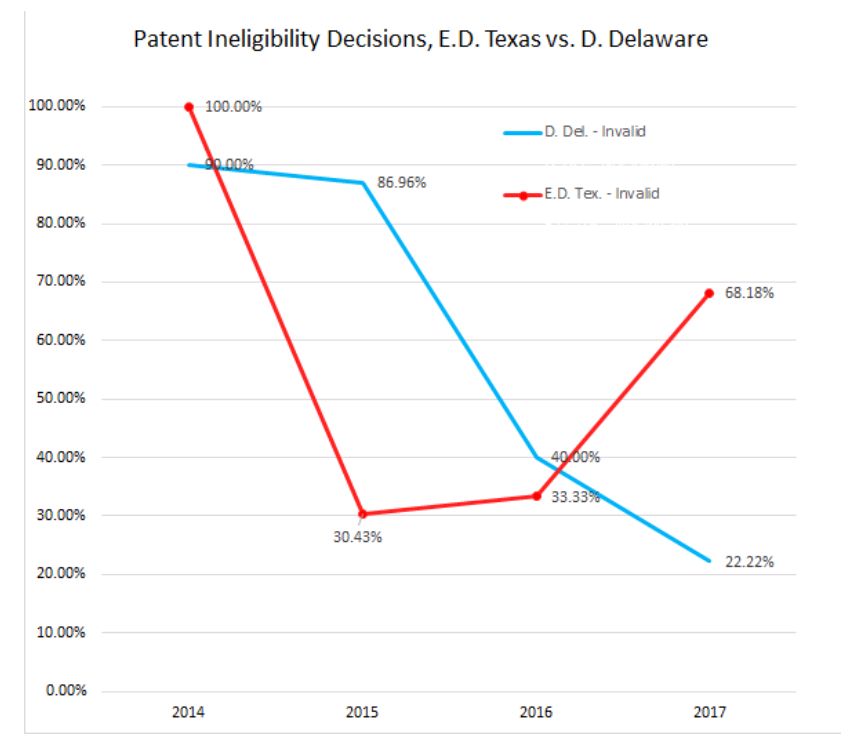The Supreme Court's recent decision on patent venue, TC Heartland LLC v. Kraft Foods Group Brands, may actually turn out to be a good thing for patentees when it comes to Section 101. But before we get to that, let's do the AliceStorm numbers:

The overall Alicestorm index of percentage of Section 101 ineligibility outcomes in the federal courts is up 0.6% from March, at 67.6%. The Federal Circuit contributed the most to the increase, issuing eight separate decisions finding patent eligible subject matter, with six of these decisions being Rule 36 affirmances. The number of motions on the pleadings index are up as well, by 1.2% from March, at 63.3%.
Turning to the monthly numbers, after the record number (35) of Section 101 decisions in March 2017 things returned to "normal" with just 15 decisions:

The bump in March contributed to a marked increase in the three-month average of ineligible decisions, jacking it up from 62% to 73%. But beneath that, we can also see that the raw number of ineligible decisions in April (13) is about the same as the high marks since August 2016, and that the raw number of eligible outcomes (2) is at its lowest level since October 2015. This puts the ratio of ineligible to eligible decisions in April 2017 at 6.5, the highest it's been since June 2015. Whether this signals a real uptick in favor of patent defendants or just a temporary blip in the overall downward trend in ineligible outcomes remains to be seen.
Turning to the motion summary:

The success rate on motions for judgment on the pleadings (JOP) is actually down 1% since last month, while the rest of the district court rates are unchanged. As mentioned above, the upswing is at the Federal Circuit, where the affirmance rate on motions for JOP is up 2% from last month, at 84%.

The Federal Circuit scorecard shows that Judge Moore has tied Judge Hughes with most Section 101 decisions (27). However, Judge Moore has found patent eligible subject matter in three cases (Thales, Enfish, CellzDirect), whereas Judge Hughes hasn't seen an eligible patent since Enfish (which he authored). As the scorecard reflects, judges Dyk and Lourie, with 18 opportunities each, have not seen eligible subject either. Such bad luck!
The Federal Circuit scorecard reflects the behavior of individual judges on the Federal Circuit. But what about pairs of judges? How do the various pairs of judges vote when they appear on a panel together? Are there pairs of judges who always go one way or the other? Does any judge appear to "influence" the others? To answer this question, I looked at every pair of judges in every Federal Circuit 101 decision: a panel with three judges has three pairs. I tabulated the occurrences of eligible and ineligible outcomes for all pairs. Here's what I found:

Each cell corresponds to a pair of Federal Circuit judges,
identified by the row and column names. Each cell shows a
ratio "X / Y," where X is the number of eligible
decisions made by the pair, and Y is the number ineligible
decisions. A blank space means that the two judges have not
appeared together on a panel for a § 101 decision.
The color coding shows the direction of the pair: green is a
significant ratio of the number of eligible outcomes to ineligible
outcomes (X>Y), and red is a significant ratio of the number
ineligible outcomes to eligible ones (X
On the other side of the spectrum, we have judges Newman and O'Malley, with two out of three decisions (Trading Technologies, BASCOM) finding eligible subject matter—the most of any pair of judges. Definitely stay for oral argument.
On the other side of the spectrum, we have judges Newman and O'Malley, with two out of three decisions (Trading Technologies, BASCOM) finding eligible subject matter—the most of any pair of judges. Definitely stay for oral argument.
Who is the judge who appears—at least in the data—to most "influence" her or his peers toward an eligible outcome? The cells on the diagonal show the ratio of eligible to ineligible pair outcomes. Judge Newman has the highest score here (0.1852), followed by Judge Stoll (0.1765). From a first glance at the table it would seem that Judge Stoll has the most impact: looking across her row, we see a series of eligible outcomes with judges Moore, Taranto, Reyna, Wallach and Prost. So numerically she appears in more eligible pairs (6) than Judge Newman (5). But Judge Stoll also appears in more ineligible pairs (28) than Judge Newman (22), and so Judge Newman's overall percentage of eligible pairs is higher. Either way, for patentees, it's a good sign if you have Judge Newman or Stoll on your panel.
TC Heartland and Patent Eligibility: Be Careful What You Wish For...
The most important patent decision of late is TC Heartland LLC v. Kraft Foods Group Brands, where the Supreme Court continues its streak of decisions reversing a patent law doctrine that it previously left to the lower courts to develop. The decision has been greeted with cheers from the patent defense bar, as it likely means the end of the Eastern District of Texas as the forum of choice for some patentees. But perhaps this is not such a bad thing when it comes to patent eligibility.
In TC Heartland, the Supreme Court ruled that "residence" in venue statute 28 U.S.C. 1400(b) means, with respect to corporations, the place of incorporation. For most corporate patent defendants, that means Delaware. The upshot is that many commentators expect a shift in patent litigation filings from E.D. Texas to Delaware.
But rather than bemoan this outcome, patentees may find it to their overall advantage in surviving a Section 101 motion.
While E.D. Texas has a reputation of being pro-patent owner, its record on Section 101 motions reveals a trend to the contrary, one that I noted in my last blog. There I showed that E.D. Texas had the largest increase in the percentage of Section 101 motions granted over the last two quarters relative to the period since Alice:

If we look over the entire period since Alice, we see a significant reversal in decision trends between E.D Texas and Delaware:

After Alice, E.D. Texas more or less conformed to expectations. Apart from a single ineligibility decision in September 2014 (accounting for 100% of its § 101 decisions in 2014), the Texas forum had the lowest rate in the country for granting § 101 motions throughout 2015 and early 2016. Then starting in mid-2016, the judges in Texas starting granting these motions with something of a vengeance. Across the country in Delaware, the opposite was happening. Early on, the Delaware judges had one of the highest rates of granting § 101 motions, and over time that rate has dropped significantly, as shown above.
For patentees then, being out of Texas and into Delaware may be exactly the right way to avoid invalidation under § 101. Corporate defendants, on the other hand, for all they have denounced E.D. Texas, were actually doing better there than in Delaware, and could now very well have lost that advantage.
All this simply reinforces my persistent belief that there is only one law that governs human affairs—the law of unintended consequences.
The content of this article is intended to provide a general guide to the subject matter. Specialist advice should be sought about your specific circumstances.




